Elizabeth Moon's Blog, page 16
February 3, 2015
Concert in the Country

This was the setup in the library before the concert. This room usually has rolling carts loaded with books; they're now in the back (behind the freestanding dark bookcase beyond the chairs.) On the right side, the aisle opened into a sort of green room for the musicians, with tables, chairs, refreshments and their own exit to the restroom. On the left, the aisle led all the way to the back door emergency exit.
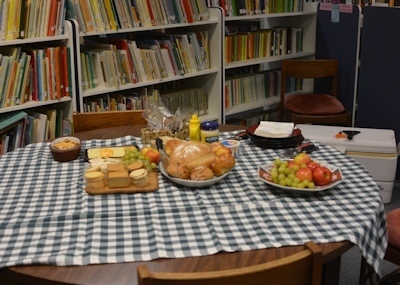
The programs for the performance were printed by a Library Board member who had leftover wedding invitation paper from a family wedding last summer.
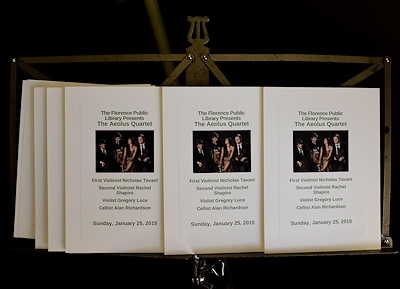 The Library Board volunteers set up coffee, wine, and snacks for the audience before the performance and at intermission...and soon the audience began to arrive.
The Library Board volunteers set up coffee, wine, and snacks for the audience before the performance and at intermission...and soon the audience began to arrive.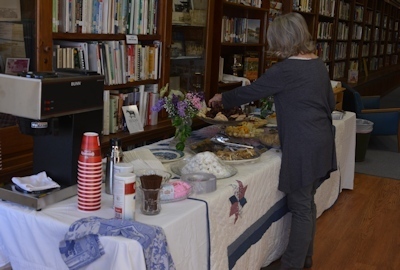
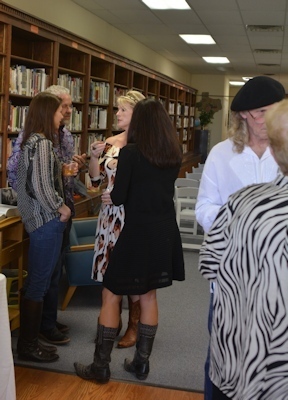
As I said, I don't have any pictures of the performance itself--but it was outstanding, not only for the quality of the music, but the electricity betwen musicians and audience. Everyone enjoyed it SO much. (As in, solid applause after every movement, and standing applause after every piece...and you could feel the intense attention of the audience throughout.
Afterward, Bob Ragan (black beret, white shirt, in picture at right above) took this shot of the musicians and a few of us who'd been involved in either the library, or getting this performance here.

L to R, that's Nicholas Tavani, the quartet's first violinist; Alan Richardson, cellist; Rachel Shapiro, violinist; Sis Beck, Library Founder and long-time supporter; Gregory Luce, violist; Mary Condon, Mayor and longtime Library Board member; me, and Colleen Beck, President of Union State Bank (also a longtime Library supporter.)
Besides the great pleasure of the performance itself, and the warm, engaging personalities of the musicians, there was the simple wonder of hearing it here, in our very small town that's so often regarded as merely a speed trap on the way to someplace else. It proved we are capable of better...we can have good things, if we go out and get them. This happened because of the hard work and imagination of a number of people in town and near town.
January 8, 2015
Unexpected Consequence of Literary Exploration
It had a strong effect. I dreamed about being lowered into a shark tank with one limb at a time dangling so the shark could bite it off about six inches at a time. When that limb was a little over half gone (and healed) whoever it was would carefully dip the next in the tank. Eventually I had no limbs left, and was helpless.
Naturally nothing in the book was that dramatic. It was, like all such books, about ordinary people living ordinary lives of apparent modest satisfaction and covert modest misery, and mostly nothing happened to change that though sometimes the people made abortive modest efforts or had pastel-tinted sex with someone who was married to someone else, which did not accomplish any real change except to expose the covert modest misery of both. The most exciting thing in the whole book was a cow moderately upset by a stranger on the railroad tracks carrying a suitcase.
No, the dream was my brain telling me how it felt as story after pointless story entered my eyes and then brain and then passed on, leaving only gaping emptiness behind.
The moderately upset cow was reluctant to come into the barn to be milked. But not for long. Because even the cow wasn't allowed strong emotion.
If the standards of modern literary fiction were applied to fiction of previous ages, we would not have any of the classics, but a collection of anecdotes told by polite people sitting around in the ancient equivalent of beige living rooms and classrooms. "In the market, it was dusty. Sarah bought two shekels' worth of unground grain. It was warmer than usual. She was aware of Josiah's wife Leah watching her. She went home and made bread as usual. First she ground the grain. She always ground the grain first, though her mother-in-law Rachel sometimes softened the grain in water before grinding it. That made the mush sticky, she said." And on through a day in which at the end Sarah gives her husband bread for supper and he says thank you but you missed a grain--look, this is still whole.
And it would be said to fairly reek with Meaning.
Oh, and nuance. Nuanced Meaning. Subtlety, one shade of beige among many but if you're really an expert, you will know exactly which one, though there may be a polite argument about whether it's beige 234 or beige 233. You must go to college and study hard to learn to tell the difference and apply the correct number to the correct shade. No one who mistakes 234 for 231 is a real reader--only 2 digits away are allowed to educated persons. Anyone who said "It's all beige" would be outed as a common person hardly able to read "See Dick run," who probably read (gasp) genre fiction and (sneer) liked it.
I am going to spend the day helping my brain regrow four limbs and my tongue, which was nibbled off by minnows in the last part of the dream.
To start the recovery process, I shall swear not to read any more literary fiction this year.
My brain's a little clearer already, though I can't trust it with the day's work of writing fiction, because what I wrote while in Beigeland certainly colored my complaints about Beigeland. I need to get rid of the beige floaters in front of my mental visin. There are red gas cans and blue gas cans sitting the yard--different fuels for the lawn tractor (which is green and yellow--not beige) and the chain saw. The cat, by the pond, is frustrated because it is frozen. She usually drinks her morning water out there. Birds were skidding on it earlier.
No, see, the beige is still in my writing. "The lion leapt on the wildebeest's hindquarters, digging in with its claws, weighing it down, kicking and [what noise to wildebeests make?], until the other lion caught up, clamped down on the wildebeest's throat...." No. Still. Damn beige. Damn the shark tank dream. Even strong language can't scrape it off my mental teeth. Between me and the story I'm writing is a so-far impenetrable pane of dirty glass, making everything beige. Or maybe taupe at the edges.
Already I can't remember the names of the people in the literary writer's books. Or the scenes, though they were described, I believe, accurately enough, just without any attendant color. There was snow here. Trees there. A field or two (with a cow in it.) Railroad tracks. Houses. Apartment buildings. Streets. The usual generic settings for modern fiction. All in the muted colors of yarn in some knitting shops where everything is dulled, softened, and if there's one skein of red, you know it's in the fall, the red is called Christmas Red, and it looks garish. People and settings and situations, all flattened, softened, made as close to beige as possible--the faintest touch of blue or green or yellow mixed with the beige, just enough to see vague outlines of the generic Everyman/woman/child, Everyhouse/store/neighborhood.
Sigh. Every year I read at least one volume of literary fiction, and most of the time I come out of it feeling as if someone had soaked me in water until all the flavor was gone. Or as if parts of me had been removed, the interesting parts. I don't mind that people write this way--it's their right, and everyone should write what he or she wants. But why, with so many examples of vivid, interesting, colorful, memorable writing in the past, is beige the only color range in the literary palette?
January 6, 2015
80 Acres: More Trail Work

Branches of a cedar elm--some alive but leafless in winter, and some dead, hung too low over the trail for either a walker or a bike rider. So I parked the bike and but them away as high as I could reach. The low cactus right beside the trail (close to the juniper) is hard to see at this size, but will need to be pruned back or (more likely) dug out, as it's at ankle-catching height.
At the end of the straight stretch ahead, a live oak tree blocks more travel on the berm, so the trail dips off the berm to the right, then makes a sharp turn left around the tree and the dead juniper right beside it. In between were a few other limbs to trim back (not seen here) but I didn't stop for pictures there.
When I rode down off the berm and around the live oak, I got a big surprise--the elbow bush had grown out in the trail so far that I had to bull through it or risk falling into a large stand of cactus.
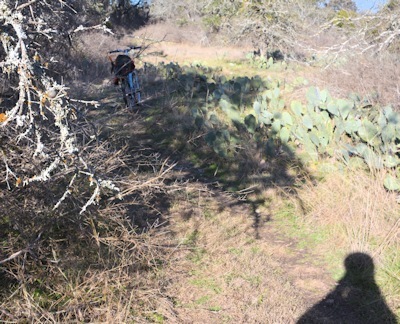
I parked beyond it and walked back to see how much I'd have to trim up. I lightened this picture a little and it's still hard to see how far out the elbow-bush goes--but you can certainly see the dead live oak limb in the foreground and the cactus along the right side of the track. The is at the bottom of the U around the tree. Here's the "before" picture taken from near my bike:

I had a lot of elbow bush to cut back. And some of the live oak, though I tried not to cut any live branches. Here's what it looked like after trimming:

That one cactus is still inconveniently close to the side of the trail, and likely to grow out into it. So a session with pickaxe and shovel is called for, plus the heaviest gloves.
I had a couple more stops before getting to the end of the east dry woods trail, but I've always loved coming out of the brush to see this:
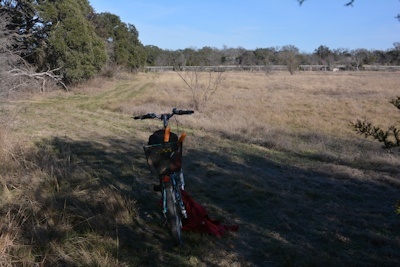
This corner often has a fine carpet of bluebonnets in spring. Those big live oaks hanging their limbs down have their trunks on the other side of the fence, alas. They belong to our neighbor to the north. Like anyone who owns land, I have a touch of "Landowner's Disease" which leads to wanting not all the land, just the land adjoining mine. It's rented out, with no one living in the house there. Sad. There was a little fruit orchard (now dead) when we moved here, and a good kitchen garden and so on. All gone.
After trimming a little in this area, I turned the bike around and rode back through to the main dry woods trail, the only way to be sure that the trimming I'd done was "enough." (And in one place it wasn't, so I stopped and pruned some more. Then I rode on, up to Fox Pavilion, and out to the north west exit, the View Corner. This is anothe place where the trail, after twists and turns, makes that one final sharp turn and provides a view of open grass, this time down to the creek woods (or would be the creek woods if it had water in it.)
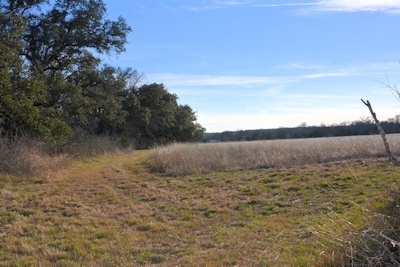
I took this picture sitting in a chair facing away from the sun, twisting around, and it's not quite level--tilted a little to the left. But it shows the line of trees on the west side of the dry woods. Many died in the drought, but some survived, in the deeper pockets of soil.
Facing into the dry woods, here's a group of cedar elms, with a very young live oak (the green leaves to the right) and more small scrubby live oaks seen beyond the thicket. The understory here is elbowbush; elsewhere it may be Mexican persimmon, elbow bush, bumelia.
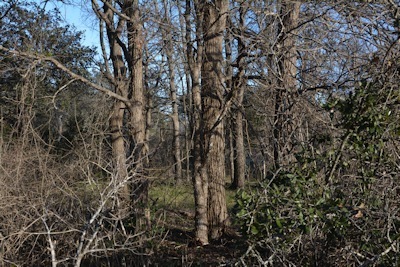
In between the elms, all down this stretch, are little grassy lawns. Deer like to rest in them, and they browse elbowbush. I used to have a trail there, until an experience tih Mr. Buzzy, a very large* rattlesnake, which coiledup and made it very clear he had no use for humans in one of his favorite spots. So I venture into the trees here only in winter, when he and his relatives are safely underground somewhere, and haven't tried to keep the trail open. *All rattlesnakes look very large when they're coiled up and buzzing at you. Mr. Buzzy certainly had an impressive set of rarrles and made an impressive stack of coils, but I am easily impressed by rattlers....into going somewhere else.
When I'd rested and had some water and a piece of bread--and the Northern Harrier who sometimes hunts the west grass, floating along just above the grass looking for cotton rats had not appeared--I went back to the bike and rode back through the dry woods, turning west as I came out to take the more western trail back to the house. That involves an intersting dive into an old ditch and cow path, then up into the near meadow and along the north horse lot fence back to the gate into the barn lots and house yard.
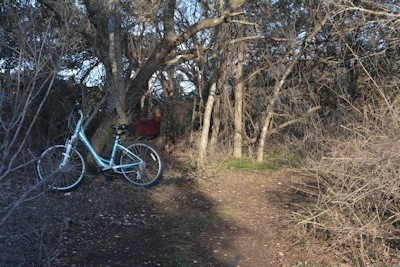
The trail from the view corner back through the dry woods curves sharp right here--though it doesn't look like it, that elbow bush has been pruned back, then twists, turns, and heads sort of south up to Fox Pavilion (which is on a rise) then down, across the berm, sharp left onto Cactus Flat, sharp right again,and various turns through the lower dry woods out into the south grass. Now that the branches aren't grabbing my legs or the wheels, or scratching arms or helmet, it's a lot of fun to ride.
January 1, 2015
Bean Jar Soup
Bean Jar Soup is an excellent soup to make in cold weather, the nastier, colder, and wetter, the better. It warms the kitchen as it cooks, and it warms the person eating it. If we've caught one of the holiday viruses, it's a nourishing meal with relatively little work, and the pot liquor of a good bean jar soup does wonders for a sore throat. I cook a ham maybe three times a year, and the ham bones go into freezer for the next bean soup...except that the Christmas ham bone goes into the New Year's Day bean soup.
Bean Jar Soup is not so much a recipe as a tradition. A ham bone with shreds of ham on it (a chunk of salt pork will do if you don't have a ham bone), an onion or two thin-sliced or chopped, 4-6 or more cloves of garlic, 4 cups (or 5, if it's down to the end of the jar, or less than 4 if there's not 4 cups left) of mixed dried beans. The New Year's Day Bean Jar Soup benefits from having all the pan juices of the Christmas ham in it as well, which means some mustard and pear jam (glaze on the ham). The beans have been soaked a good long time (black beans, in particular, benefit from longer soaking, and we aren't modernists who go all fussy if the beans aren't al dente. Bean Jar Soup is comfort food--you don't want to be breaking your teeth on a hard one, or get mouthful of dry-floury bean innards. They should be soft.)
With the ham bone and pan juice in the bottom of a 10-12 quart pot, add in the beans, the onion(s), the garlic and bring to a boil, then reduce to simmer. Although it's nice to have the onion and garlic prepped ahead of time, it's not necessary--if it goes in later, it's not a disaster, because of the long cooking time. Then let it alone, barring an occasional stir. Depending on the saltiness of the ham, you may need to add some salt, and some pepper can go in early or later. You can add other spices if you want (I sometimes do, though not to the New Year's version) but the main thing is to let it cook until the pot liquor is densely opaque, a rich, velvety delight. It will start smelling good early on. Don't be tempted. Keep it on the burner. It will smell better. Ignore it except to check the fluid level and stir. (Beans will glue themselves to the bottom of a pot and burn.) It will smell better than before. Hold out...the longer it goes, the better it is. (In fact, you can't get it to its best in less than 8 hours, although it's usually delicious by 4 hours in.) When temptation's about to overcome you, test one of the black beans. They're the slowest to cooperate in the "give up and be soft" struggle (of the beans I use.) Then find one of the garlic cloves (why I leave them whole in this) and see that it's soft as well--completely cooked. When the black beans and garlic cloves are soft, it's time for a first dish of soup.
It's also a time you can make the best bean dip you ever had in your life. Put a cup of the beans (no big hunks of ham) in a deep bowl or heavy jar and hit it with an immersion blender (stick blender) . Then stir in the finely diced hot pepper of your choice (or not-it's up to you) and bring out the tortilla chips.
But back to the soup. Say it's a cold, dank, night and you've come in tired, not even that hungry because all your muscles have tightened up against the cold and wet, and winter's a long way from over. And there's the Bean Jar Soup, hot, steamy, sending that bean-and-ham fragrance into your head. Dip out a bowl of it. If you have cornbread, that's a bonus, but if not, any other will do. If you like spicy, toss a spoonful of something--diced jalapeno, Tabasco sauce, a good hot salsa--on top, and then start eating. All the goodness of the beans starts flowing into you; you don't have to chew or anything, just savor it in your mouth and swallow. At some point, with me, my eyes open back up all the way, the feeling of being cold, tired, out of energy or caring fades, and I'm restored to my normal sels: awake, interested, a lot less inclined to crawl into the sack and pull the blankets over my head.
Like most homemade soups, it's even better the second day, but it's also a good soup for freezing, because sometimes you need a slug of bean soup when you haven't realized it the day before (and thus didn't soak beans overnight.) And in summer, you may want to eat bean soup but not want to heat the kitchen up enough to make it.
Just had a test bowl of today's. The white beans were contributing to the pot liquor; the kidney beans and black-eyes peas were soft but still togehter, and some of the black beans required chewing and were slightly floury inside. Yup, at four hours it's not really ready. The pot liquor was opaque but not that opaque. It should look like gravy, not soup juice. The meat hasn't all fallen off the ham bone. So another couple-three hours should make a big difference.
You can dress up Bean Jar Soup with grated cheese on top, or diced raw onion, or parsley, or cilantro, or pretty much whatever you want: diced tomato, diced hot pepper, croutons...but it's good right out of the pot on its own and even slightly underdone (what I just ate) it's sustaining food. (I might put another onion in, and the rest of the garlic...or not.)
When it's done, I'll take a picture and add it to this post.
December 29, 2014
Work & Play
Meanwhile, husband was working on the south fence--doing it by himself, with his health problems, is taking him a long time but he's very determined, and he's got most of it done. (He's also done the west fence. The north fence...is still a problem, and the highway-side fence, that we were going to have done...the contractor said he can't hire the labor now and he's too old to tackle it by himself, so we're considering what to do about that. ) He carries his materials & equipment in the little trailer behind the lawn tractor; I carry mine in the back basket of the bike. Here's a picture of the "work vehicles" partly loaded.
 You can see the orange handles of my Christmas-present lopping shears in the bike basket, my water bottle on the fender of the lawn gractor, and some T-posts sticking out the back of the little trailer. Also in my basket was the camera in its carrier, a pair of binoculars, and some crackers.
You can see the orange handles of my Christmas-present lopping shears in the bike basket, my water bottle on the fender of the lawn gractor, and some T-posts sticking out the back of the little trailer. Also in my basket was the camera in its carrier, a pair of binoculars, and some crackers.I started working on the dry woods trail, also known as Fox Water or Fox Pavilion trail. It enters the dry woods on the south, and goes up to Fox Pavilion (a rain barn) where the first wildlife waterer was put in, and on up to the north fenceline, then turns west, wiggles south to clear the fencerow growth, and comes out into the west grass at the upper end of the north fence trail.
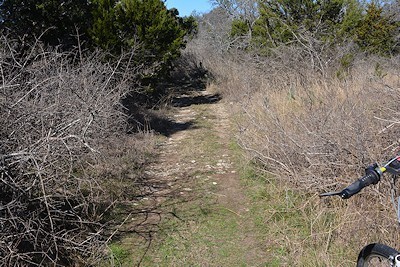

Left: I've just started trimming on the right side of the trail--about 3 feet of trail cut back on right. You can see that ahead, the elbow bush is out into the trail. Right: I've added lines to make this clearer. On the left, completely untrimmed, the elbowbush sticks out well into the track, including up high. The leftmost red line shows a minimum distance to cut it back from where it was. Farther ahead, you can see that a branch of juniper sticks out lower, almost across the track. Avoiding it means getting too close to a cactus on the right. So I trimmed that juniper both up higher and also back, giving someone on a bike (or walking) a clearer view of that turn to the right (which is an S curve, actually) and any hazards that might be on it.
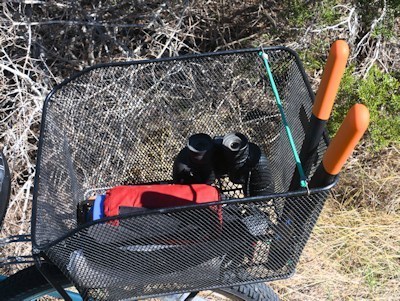
Crackers (salt source), Water, Binoculars, Lopping Shears (Camera--in use)
For some jobs, I might also carry a folding pruning saw. But the new lopping shears handled what I needed to cut today. Or I can carry a sack of bird feed, or even a salt/mineral block, though if I have lot of that to take, I'll grab the little tractor and trailer instead.
R- found a desirable native plant seedling earlier in the day, an Agarita (Berberis trifoliata). We have tried to reintroduce agarita in the dry woods (an appropriate setting--it likes well-drained rocky soil and is native in this area) but three of four attempts failed in the drought. One survived and is probably the parent supplying the berries from which this seedling came (the seedling is about eight feet from the presumed parent.) Here's a picture of the baby, nestled under a juniper (junipers serve as protection for quite a few things that can stand shade when they're young.) You can just see the holly-shaped leaves. A healthy adult has fragrant yellow flowers and translucent red berries that make good jelly.
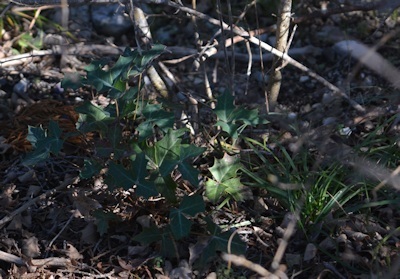
For the past four years, the lichens on trees and rocks have suffered from the drought, but they're hardy and try to come back with every rain. I saw an exuberant display of them on this trip, as we've had moist weather this fall--some rain, some mist, and less of the harsh drying winds. No longer dry, flat dead-gray encrustations on dead twigs and limbs, but the bright orange fruiting bodies and green "stems".

After finishing the maintenance work on the Fox Pavilion trail, I rode over to where my husband was putting in T-posts and staves in the south fence. By the time I got there, he had all the T-posts in and was tying the barbed wire to the T-posts, then installing the twisted wire staves.
 That brown pipe is a device for driving T-posts into the ground by hand. The pipe has a cap welded on one end; you put the open end over the T-post, then lift it with the handles and let it drop on the T-post, keeping it vertical so the T-post stays vertical. It's not an easy job; it's heavy. Beside the T-post driver are some twisted-wire stays. They're twisted onto horizontal strands of fence wire (smooth or barbed) to help keep the strands a constant distance apart. That strengthens the fence and also prevents animals (cows, particularly) from pushing their heads between two wires and heaving them apart so they can crawl through. But this is not a goat fence and will not deter goats. At all.
That brown pipe is a device for driving T-posts into the ground by hand. The pipe has a cap welded on one end; you put the open end over the T-post, then lift it with the handles and let it drop on the T-post, keeping it vertical so the T-post stays vertical. It's not an easy job; it's heavy. Beside the T-post driver are some twisted-wire stays. They're twisted onto horizontal strands of fence wire (smooth or barbed) to help keep the strands a constant distance apart. That strengthens the fence and also prevents animals (cows, particularly) from pushing their heads between two wires and heaving them apart so they can crawl through. But this is not a goat fence and will not deter goats. At all.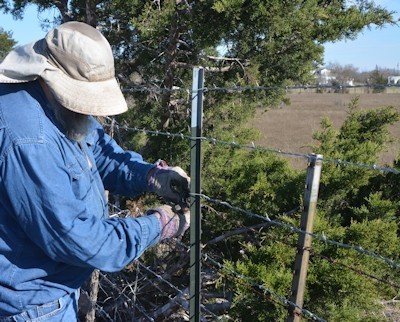
Twisting short length of smooth wire around T-post and barb-wire strand to set distance.
You can see the old fence just outside the new one--the leaning, faded T-post and old (thin, rusty) barbed wire. The new fence is nine strands and more than a foot taller than the old one.
I'll have to take more pictures of putting the stays in--thought I'd done that today, but apparently I was too busy watching and listening, and not pushing the little button.
A good day's work by both of us, but I'm going to be stiff in the morning!
December 22, 2014
TimeTo Bring Home The Tree
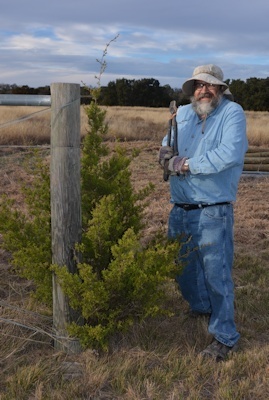
This year's choice. Ashe juniper tends to rotund, so nice shaped ones are short
At this age, they have skinny trunks, so the big lopping shears took it off at the ground.

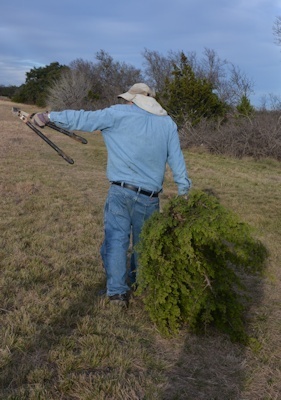

Unfortunately, we haven't found the tree stand that can deal with skinny trunks (most commercial trees now have thick trunks) so we're not sure how this little tree will be supported. I suppose we could screw an eye into the ceiling and hang it from there....
Removing some of the young Ashe junipers also fits in with our wildlife management program. I've taken out a lot of them with lopping shears myself, over on the west end where R- has chain-sawed a number of bigger ones to open up the grassy area there. We don't remove them in fencerows (except to repair/build fence when it's necessary) or in the woods areas.
December 20, 2014
Where I ride II
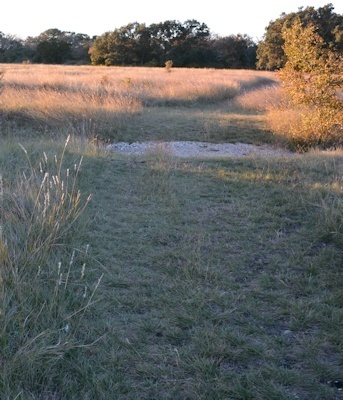

Entering Dry Woods-Fox Water trail
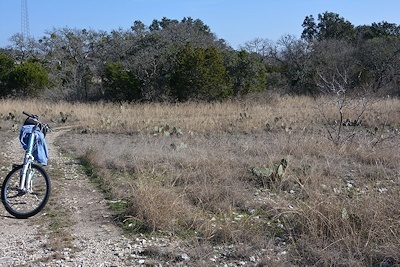
Cactus Flat is large opening in dry woods between lower & upper levels
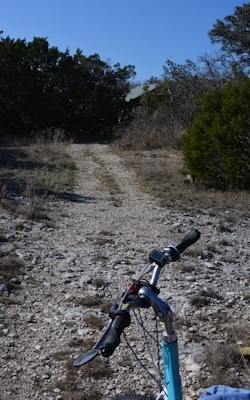
Sharp little rise onto solid rock, then gentler to Fox water's rain barn (roof just visible)
Easy to ride down from Fox; tricky (for me) to ride up from Cactus Flat.

The rock crossing at Westbrook, though rough and undulating, is actually easier both directions because the upslope has a straight approach from either direction.
December 16, 2014
Where I ride

The first picture is taken from "above" that area, on the way back. First I come off a little bank on a right turn (picture taken from the end of the right turn, while walking the turn yesterday--parked above it, walked back to take pictures. You can see the track starting to turn left.
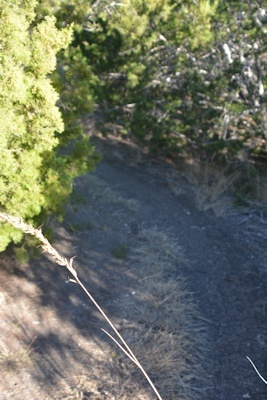
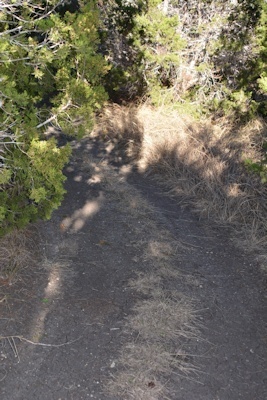
L: At this point I had realized I was going too fast and braked too hard. Back end of bike came off the ground, basket hit me in the back, hard, and though I stopped I was off balance and leaning left--couldn't get me and the bike both back up. Turned over into tree on the left.
R: This is the continuing curve beyond the picture on the right.

As soon as you stop turning left, you're turning right (and there's another S-curve after that, but shallower). The tracks are made by a lawn tractor that we use to haul tools and supplies around (it has a little trailer) for building fence, servicing the water pumps at the wildlife waterer, carrying supplemental feed for the winter-resident birds, etc. It's not nearly as wide as a car, which means we are leaving more habitat undisturbed. These maintenance trails are, except on the open grassland part, very twisty, often following old cattle trails from when this was leased land with cattle on it.
Riding any of the woods/brush sections successfully in both directions on the same ride feels like an accomplishment. It's just scary enough and has some of the same challenges as riding a horse over fences (though this bicycle is not rated for any jumping!) in that how you come into a sharp turn matters, and so does setting up for a sequence of turns. There are places (in the open) where you can let the bike "gallop on" and places where it's necessary to change direction, speed, "collection" (gears) frequently and rapidly without error--or else.
Riding on pavement (even rough pavement) is very different. I enjoy both and particularly enjoy that I can go places and accomplish things without driving. Like picking up mail, going to the bank, going to the convenience store, the larger grocery store downtown, the old city park or the new one (the new one's trickier and involves a difficult highway crossing at one point, but...it's doable--all pavement riding. Or going out on the land to do the trail maintenance and the water checks and documentation (by photography) of wildlife at the waterers and feeders more quickly than I can walking it.
December 12, 2014
Torture
Nothing justifies torture. Torture is wrong. The torture apologists are the Big Brother of 1984...trying to rename it to make it prettier, less offensive. It's not the name--it's the reality. Waterboarding is torture. Deafening noise is torture. Forced sleeplessness is torture. And everybody, including the torture apologists, knows that at root--because these are the kinds of things that even they call torture when it's done by someone else, especially by an enemy. It's not "enhanced interrogation techniques"--it's torture. Torturers themselves should not be tortured--because torture is wrong. Serial killers should not be tortured--because torture is wrong. The evil men who allow, encourage, support torture should not be tortured--because torture is wrong. There are people in this world I would happily send to execution, if it were my choice, but I would not see anyone, anywhere, for any reason, tortured....because it is wrong. It is a wrong so wrong that it contaminates those who do it, turning them as inhuman as they believe their victims are. It is a wrong so wrong that it contaminates the entire chain of command that allows it.
When the situation at Abu Ghraib came out, I wrote a fairly long post here on LiveJournal about it (can't get back to it--there;s no easy way to search. However, I did cite Bush's responsibility for Abu Ghraib on my website in 2004, in an essay on Bush as Commander in Chief. The LiveJournal post would was written within a month after the Abu Ghraib stuff came out, and I also discussed it on SFF.net, where other veterans agreed with me that such behavior means a chain of command that's rotten at the top, not just at the bottom where the deeds are done.
The fact that torture has been around for the entire history of the human race (judging by some skeletal remains showing its effects, and artwork the same) does not make it OK, anymore than the existence of murder, rape, etc. make them OK. I learned as a small child that "Well, Tommy did it too" does not excuse a misdeed. Wrong is wrong.
The fact that sometimes (not always, or nearly as often as torture apologists would have you believe) the person being tortured reveals information that is a) true and b) of use does not justify torture. No matter how "important" it it, the damage done to the torturers is greater--individually, by becoming people who can do it, whatever group they represent, by becoming a society that endorses it, by the damage to their reputation as well...though once the damage is done to their character, their reputation hardly matters.
You will hear people say that it's unpatriotic, even treasonous, to oppose torture. No. It is unpatriotic and treasonous to ignore the harm done to individuals, groups, and nations by the practice of torture, in order to endorse something that is morally wrong. In the case of government officials who endorse torture, enable torture, it is also a violation of law, in addition to morality (we all know that law and morality do not map 100%, but in this case they do.) The Constitution says that treaties signed by this nation are the same as our own laws, under the Constitution--they have Constitutional power, (which is why the early Presidents were extremely reluctant to make lots of treaties.) The United States, along with other victor nations of
WWII, pushed for the international recognition that torture was wrong and that prisoners of war should be treated fairly. The Geneva Conventions do apply to us.
Does this mean taking some damage rather than do evil? Yes. That's what moral choices are about, after all. It takes courage and justice to stand against the temptation to evil, when it looks like evil may bring immediate profit. And torture apologists always make the case thatthe one piece of information needed to save a city or a campaign is held by an enemy who is (another 1984 bit of language) "noncompliant." That if you don't torture the people who don't reveal what you think they're concealing, your own people will suffer for it. (The problem with that reasoning will be discussed later.)
But self-interest on the side of right, in this case. Torture exacts a price from the torturer and from the society that supports torture. All of the evils that begin with dehumanizing people damage those who think up or practice them. One of the causes of war-related PTSD is not merely what was done to the person with PTSD, but what that person did--against their own moral code--to others, sometimes following orders and sometimes in moments of anger or terror or both. More than that, the experience of ignoring the humanity of the person you're torturing changes those who do it--makes them less empathetic, less loving, less likely to treat all others--enemy or not--as fully human persons with a right to be treated as human--humanely. Their families suffer. Their neighbors suffer. Their communities suffer. The more their abuse of communication--of language--contaminates common speech, the more their attitudes about people--their cynicism, their contempt, their cold and vicious hearts--contaminate the media and the common experience of their culture, the more damage their communities and cultures and societies and religions suffer. Torturers, to keep doing it--and their apologists--have to construct a new moral code in which torture is OK if it's our torture, and that moral code seeps into every human interaction. Rape. Human trafficking. Racism, Gay-bashing. Women-hating. Domestic violence. Child abuse. Abuse of power by law enforcement, by prison guards, by the government....all thrive in the atmosphere that makes torture acceptable...because all of them--to be acceptable--depend on defining the victim as less than fully human.
Someone who considers African-Americans fully human never calls them "animals" or "niggers" or "thugs," does not assume that every Black person in a store is a shoplifter, every Black person in college "just got in because he was Black," every Black woman walking with a White man is a prostitute.. Someone who considers women fully human doesn't yell comments about her on the street, doesn't get mad if she doesn't want to date him, doesn't assume that all women lie when they say theyve been raped. Someone who considers children as fully human doesn't cover up child abuse, doesn't abuse children, doesn't sanction policies that put children at greater risk of abuse, and certainly doesn't let a child rapist off on the grounds that a 3 yo child "seduced" him. Someone who considers gays and lesbians as fully human does not condone attacks on gays--economic, political, religious, or physical. It's not a matter of whether someone likes someone in one of these groups--there are people I personally dislike, but still acknowledge as human beings. It's not a matter of agreement or disagreement (although these days people do tend to assume that if you don't agree with someone it's the same as not acknowledging their right to exist...but that again is a symptom of the toxic effect of accepting torture--and racism, misogyny, homophobia, etc.-- as the price of doing business.)
The cost of torture is demonstrably greater than any claimed benefits from it. So why is it popular among some people? Because some people were brought up mean, allowed to think that they had enormous entitlement (because they were rich, because they were powerful, because their parents were totally crap parents...take your pick ) and for them torture is a way of proving their power. Making powerless people scream gives them a thrill. That's not something to celebrate. That's not "being a man." That's being a bully.
Torture is wrong.
Addendum, an hour or so later. Thanks to a friend on another venue who gave me this link:
https://www.aclu.org/national-security/acts-courage-against-torture
Maj. Gen. Taguba (ret) is one of my heroes for the way he handled the investigation of Abu Ghraib, knowing this would deep-six his career. In a just country, he would have been promoted for his character and be on JCS.
December 11, 2014
Apple Pot Pie
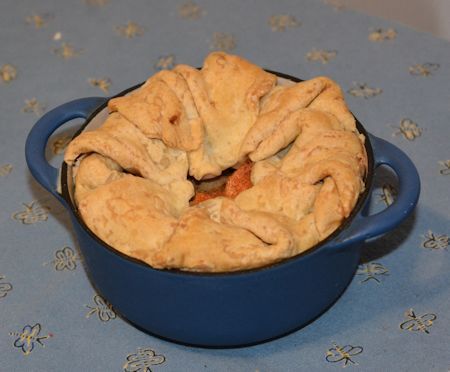
A One-Apple Pie
Just one apple? Need two desserts? A small casserole dish, one apple, one round of piecrust...sugar, cinnamon, and butter...makes a nice pie. Half makes a substantial dessert. Choose a tart crisp apple like Braeburn, Honeycrisp, Pink Lady, etc. Do not use typical "pie" apples like Cortland or Granny Smith. One of the big Honeycrisps will be too big, but will make a good pie and just eat the leftover quarter or quarter and a half. This little baking dish is a Le Creuset, cast iron with porcelain outside and in.
Quarter the apple and core it. Butter the inside of the dish. Put the round of piecrust into the dish, gently shaping it to the bottom and sides. What hangs over will be folded in. Thinly slice each quarter (THINLY) and layer the slices in the baking dish. Layer no more than 2 slices deep before sprinkling generously with sugar and cinnamon and dotting with butter. Repeat layers until out of apple...should be at least level with top of dish or humped a little. Fold excess piecrust over, leaving hole in middle; put dot of butter in hole. Bake uncovered in 350 F oven until crust is golden.
Pie is good warm (not hot) with vanilla ice cream melting into it, or cold. Or whipped cream. Or just heavy cream. Or nothing at all. Run a knife around the edge to loosen any place the juice got through and stuck, and cut across the middle with the knife. A big cooking spoon will then lift out half (though you may need to get pieces of crust off the bottom to add to that serving.
Elizabeth Moon's Blog
- Elizabeth Moon's profile
- 2621 followers



